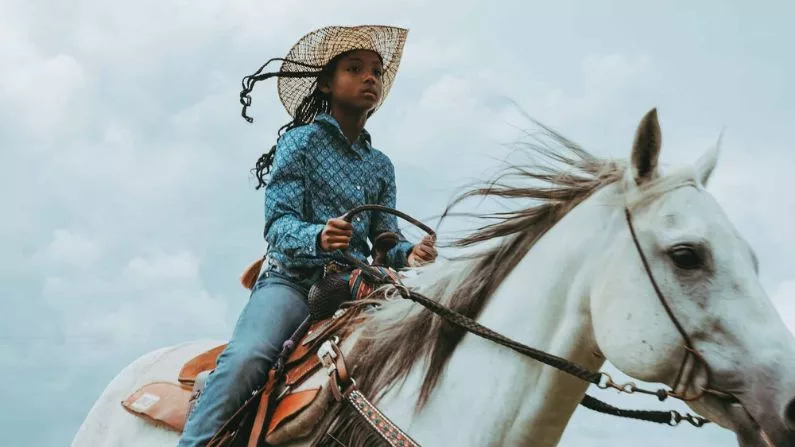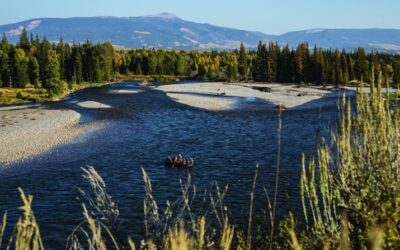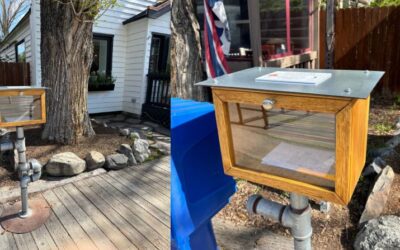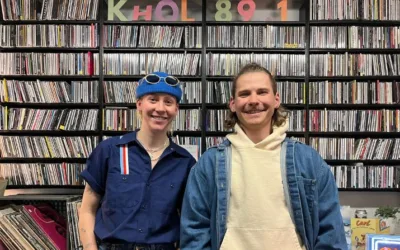A new exhibit in the Center for the Arts features photography from Ivan McClellan who documents Black cowboys in the American West. He’s gained national recognition for his photo series “8 Seconds” and for launching a Black rodeo in Portland, Oregon this past June. Eight seconds is the length of time a cowboy or cowgirl aims to ride a bull.
This interview has been edited for brevity and clarity.
EMILY COHEN/KHOL: To begin, could you tell us how you got into this work? How did you get into photography? And also, where did the idea to take photos of cowboys and rodeos come from?
IVAN MCCCLELLAN: I was taking street photos in Portland, so I would get off from work and I would just walk around and meet people and take their portrait wherever it was, whatever the weather conditions were, whatever was in the background. I would just take pictures of people. And that got me really good at getting a beautiful photo in any, any circumstance and really got me really good at not being shy and just interacting with anybody that I thought was interesting.
And it was right around that time of doing that for a few years that I ran into a guy named Charles Perry, and he was a filmmaker, and he told me he was working on a film about Black cowboys. I said, oh, like a Western. He said, No, like a documentary. I kind of laughed at him because I thought I knew a thing or two about cowboys. I had grown up in Kansas City. I would watch Bonanza and Gunsmoke reruns on TV. We would go to the American Royal Big Rodeo in Kansas City and we would sing the national anthem there. Everybody was white, besides the choir.
The only black cowboys that I knew about were Cowboy Curtis on Pee Wee’s Playhouse. Laurence Fishburne played him and then Sheriff Bart Blazing Saddles. So I thought of Black Cowboy as a joke. So I kept talking to Charles. And is that well, come with me to a rodeo in Oklahoma this summer. And I went in and I was just blown away by what I saw there.
KHOL: Are you seeing Black cowboys throughout the West or are folks mostly concentrated in certain areas?
MCCCLELLAN: There are some Black cowboys in just about every state. But the large concentration are where you’re going to see a lot of black cowboys there in Oklahoma and Texas. And the ones that are further out west in the true West aren’t particularly trying to be found for the most part.
KHOL: What are you shooting on?
MCCCLELLAN: I shoot on a medium-format Fuji camera. It’s the exact wrong camera to shoot a rodeo with. It’s slow, it’s clunky. But when it does get in focus, it’s you get the most beautiful photos. I’ll be in the press area at a rodeo and everybody else will have a big long white Cannon lens. And they’re just putting their finger down on the shutter and taking thousands of photos. And I’ll leave a rodeo with 200 photos, most of them completely out of focus. But with 10 that that look really good.
KHOL: Your photos have an almost vintage quality in the color. Is that something that you are doing in the setting as you’re taking the photo or that you’re doing in post-production?
MCCCLELLAN: It’s post-production for the most part. I kind of break down the color settings completely and rebuild things from scratch. My day job is for Adobe, and so I work on photo editing software during the day. And so when I go to edit, I’m like testing out new features, experimental stuff, and really dialing in and getting my photos exactly how I want them.
KHOL: What are you hoping to shed light on in this storytelling?
MCCCLELLAN: The Black rodeo came about because Black competitors couldn’t compete in white rodeos, and so they started to have their own event so they could show off what they could do and make a little bit of money. Now the big pro rodeos allow Black people to enter. They allow anybody to enter, but their chance of doing it really well compared to the resources that white competitors have are pretty low. They don’t have the same sponsorship dollars. They don’t have the same legacy of people training them. They don’t have access to the same ranches and resources that a lot of the white competitors have. And so I think the legacy of “8 Seconds” is really leveling up a lot of these guys and giving them those resources that they need to really compete at a high level.
I’ve gotten people sponsorships. I’ve had them at my own rodeo that I just produced in June. A typical black rodeo will have five to $15,000 in prize money. Our rodeo had $60,000 in prize money. So we were really trying to level up that community and really give back.
KHOL: Well, thanks for coming to Jackson and thanks for making time today.
MCCCLELLAN: I love it here. I love Wyoming. Any excuse to come out here, I’ll take it.
McClellan’s photographs can be viewed in the Center Theater Gallery through August 31st.





